When to Plant Petunias in the UK: Seasonal Tips for Gardeners
Are you dreaming of a garden filled with bright, colorful blooms? Petunias might be just what you need. Known for their beautiful flowers, these plants thrive in UK gardens when planted at the right time. The ideal time to plant petunias in the UK is from May to June, after the risk of frost has passed. This ensures they get a great start and bloom beautifully throughout the warm months.
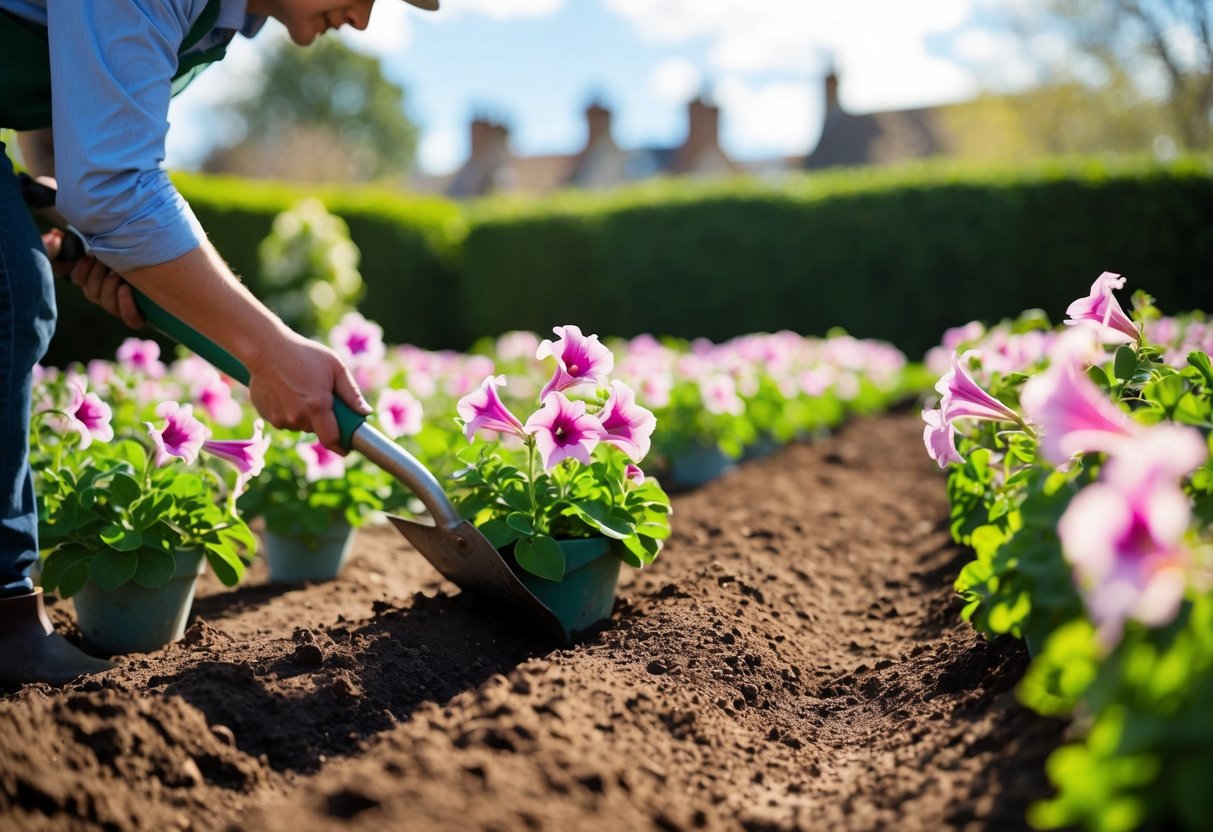
When you’re ready to start planting petunias, consider your garden space. Will you use pots or the ground? Petunias love plenty of light and well-prepared soil. If you’re using containers, make sure to choose the right size and type to help your petunias flourish.
Planning like this ensures your petunias show off their vibrant colors all season long.
Don’t forget about watering habits. Whether they’re in the ground or pots, petunias need regular watering during dry spells. Early mornings or late afternoons are the best times to water them to prevent any damage to the leaves and flowers. Your careful attention will reward you with a stunning display of petunias that everyone will adore.
Understanding Petunias and Their Varieties

Petunias come in many types, each with unique features. You can choose between different growth habits and lifespan, making them a versatile choice for your garden. Below is a closer look at the types of petunias and their growth patterns.
Types of Petunias
There are several petunia varieties to explore. Grandifloras have large, eye-catching blooms, while multifloras offer smaller but more abundant flowers. For compact gardens, millifloras are perfect with their miniature blooms.
If you’re interested in hanging baskets or cascading displays, trailing petunias, like the Wave series, spread extensively. These types create a carpet of color. Bedding plants, on the other hand, include upright varieties that work well for borders or flower beds.
Tumbelina series and double blooms add texture and flair to your garden. Considering these options allows you to tailor your garden to suit your style and space.
Annuals vs. Perennials
Petunias are generally grown as annuals, meaning they complete their life cycle in one season. They bloom from spring to frost, adding color during the warmer months. However, in milder climates, petunias may survive as perennials and continue to grow year after year.
Choosing between annuals and perennials depends on your gardening goals. If you prefer planting new flowers each year for variety, annuals are a great choice. For a more permanent setup, consider perennial varieties in suitable climates.
Specific types like spreading petunias thrive in both setups, offering flexibility. Your choice will guide how you plan your flower beds and maintain them throughout the seasons.
Preparation for Planting
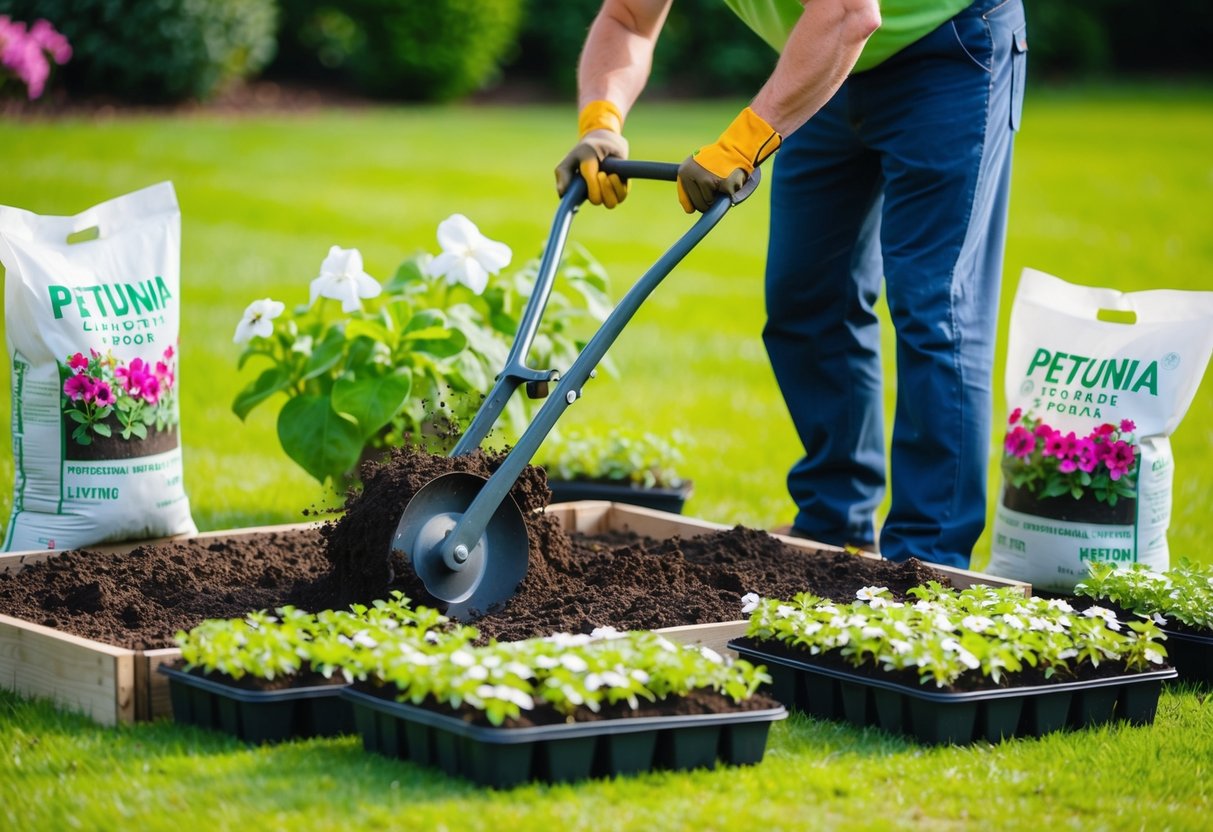
Preparing to plant petunias involves selecting the right soil and compost, as well as choosing appropriate containers. Both are crucial for healthy growth and vibrant blooms. Using too much water during planting can cause root rot.
Choosing the Right Soil and Compost
When choosing soil for petunias, aim for a rich, fertile soil. Start with multi-purpose compost that’s combined with well-rotted manure or garden compost. These provide petunias with essential nutrients. Perlite can be mixed in to enhance drainage and aeration.
A balanced mix of organic matter such as coconut coir helps retain moisture without waterlogging. This creates a well-drained soil condition ideal for petunias. Light mulching can keep moisture in, especially during warmer months. Ensure that the soil retains enough moisture without becoming soggy.
Finding the Perfect Planting Containers
Choose containers that fit the location, whether they be window boxes, hanging baskets, or standard pots. Containers should be 12-18 inches wide to accommodate root growth. Make sure they have good drainage with holes at the bottom to prevent standing water.
Hanging baskets and window boxes are perfect for displaying cascading varieties. These containers need extra attention to watering because they dry out faster. Opt for containers with a blend of potting compost and amendments for enriched planting media. You might find it helpful to use a liner in baskets to retain moisture and support the plants.
Optimal Planting Times and Conditions
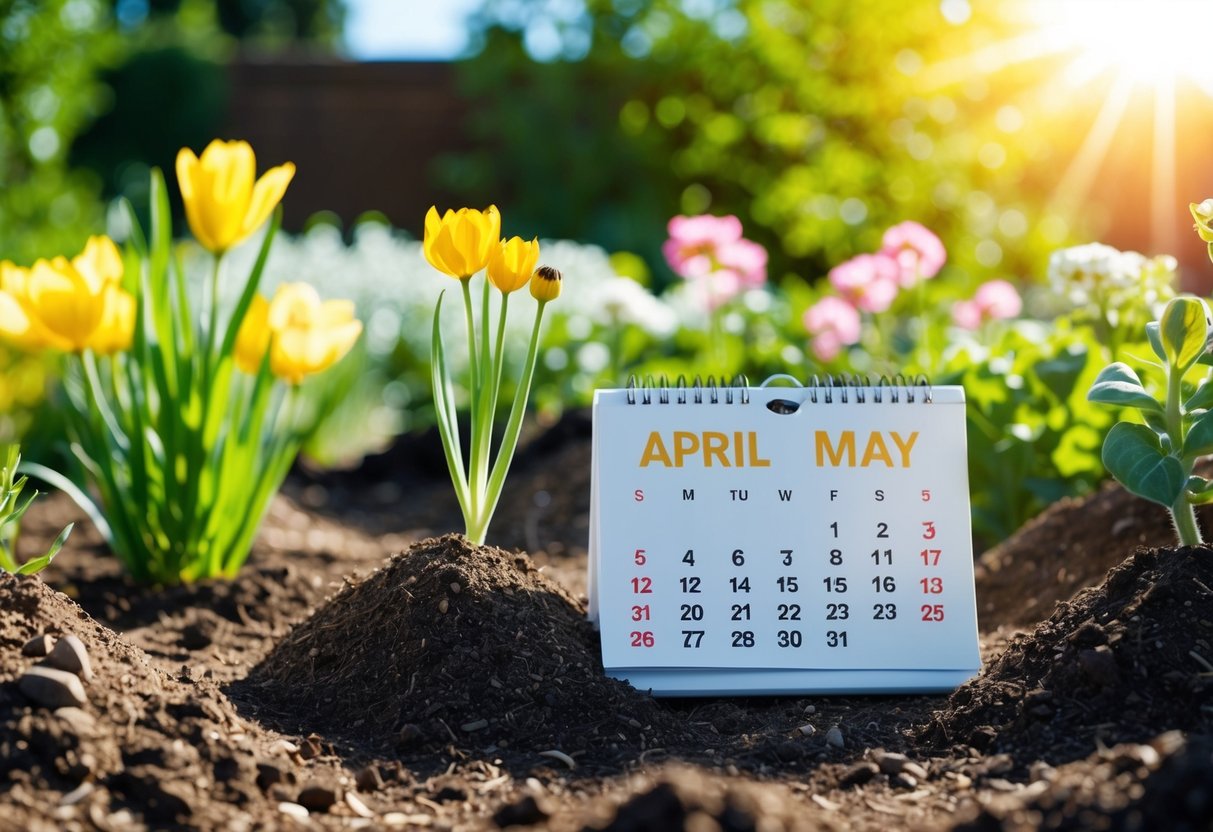
For a vibrant petunia display, choose the right time and conditions to plant. Pay attention to local frost dates, ideal temperatures, and necessary light conditions to ensure your petunias thrive.
Timing Your Petunias Planting
You should plant your petunias in the UK after the last spring frost to avoid frost damage. This typically happens between May and June. Make sure you know the last frost date in your area to plan your gardening.
If you’re starting from seeds, begin indoors about 10 weeks before the expected last frost. This gives seedlings time to germinate before they are taken outside. Petunias prefer full sun, so choose a spot that receives at least six hours of sunlight a day for the best growth.
Climate and Temperature Considerations
Petunias thrive in warm temperatures and can tolerate heat, making them an excellent choice for summer displays. Maintain a temperature of 18-24°C (65-75°F) when germinating seeds. Once established, they can handle temperatures as low as 10°C (50°F) but prefer warmer conditions.
Plant them in well-draining soil with a pH level between 6.0 and 7.0. While they enjoy full sun, in regions with intense heat, a bit of light shade might prevent wilting. Ensure the growing conditions include regular watering, especially during dry spells, to keep them healthy and flowering throughout the season.
Cultivation Techniques for Healthy Growth
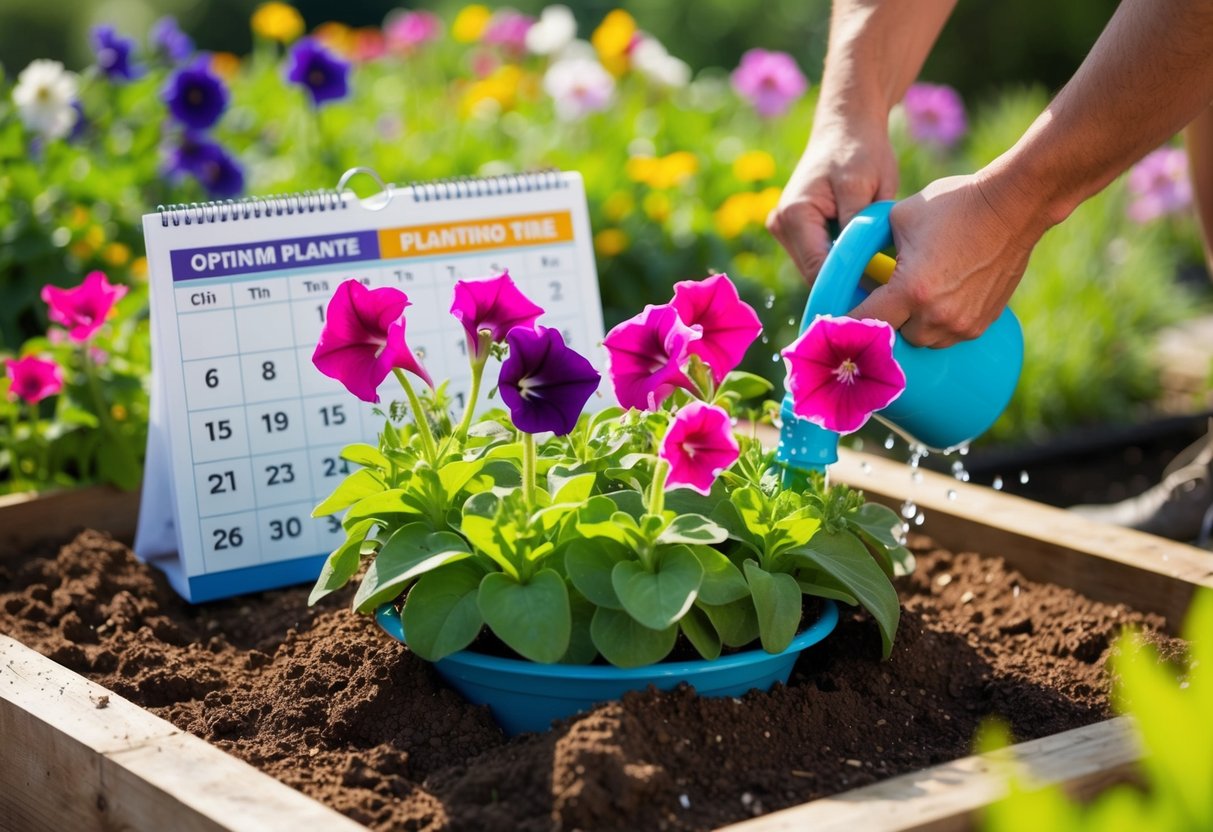
Cultivating petunias involves careful attention to watering, feeding, pruning, and deadheading. By following these specific techniques, you can ensure vibrant and continuous blooming throughout the growing season.
Watering and Feeding Your Petunias
To keep petunias healthy, regular watering is crucial. Water them every 3-5 days, focusing on the base rather than the foliage to prevent damage. Be sure your pots or garden has good drainage to avoid waterlogging and potential root rot. Checking soil moisture before watering can help you determine when your plants need it most.
Feeding is another essential part of caring for petunias. Use a liquid fertilizer high in nitrogen every two weeks. This helps encourage lush, healthy growth. Additionally, a balanced liquid plant food can promote more blooms. Mix the fertilizer according to the package instructions to avoid overfeeding.
Effective Pruning and Deadheading
Pruning petunias involves removing any side shoots that appear on the plant. This helps focus energy on producing large, beautiful flowers. Make sure to prune gently with clean tools to avoid damaging the plant.
Deadheading is equally important in petunia care. Regularly remove spent blooms to encourage new ones to form. This not only keeps the plant looking tidy but also promotes continuous flowering. Engage in daily or frequent deadheading during peak blooming times for best results.
Proper spacing during planting ensures good air circulation, reducing the risk of diseases. Keep these simple yet effective practices in mind to cultivate healthy, thriving petunias.
Protecting Petunias from Pests and Diseases
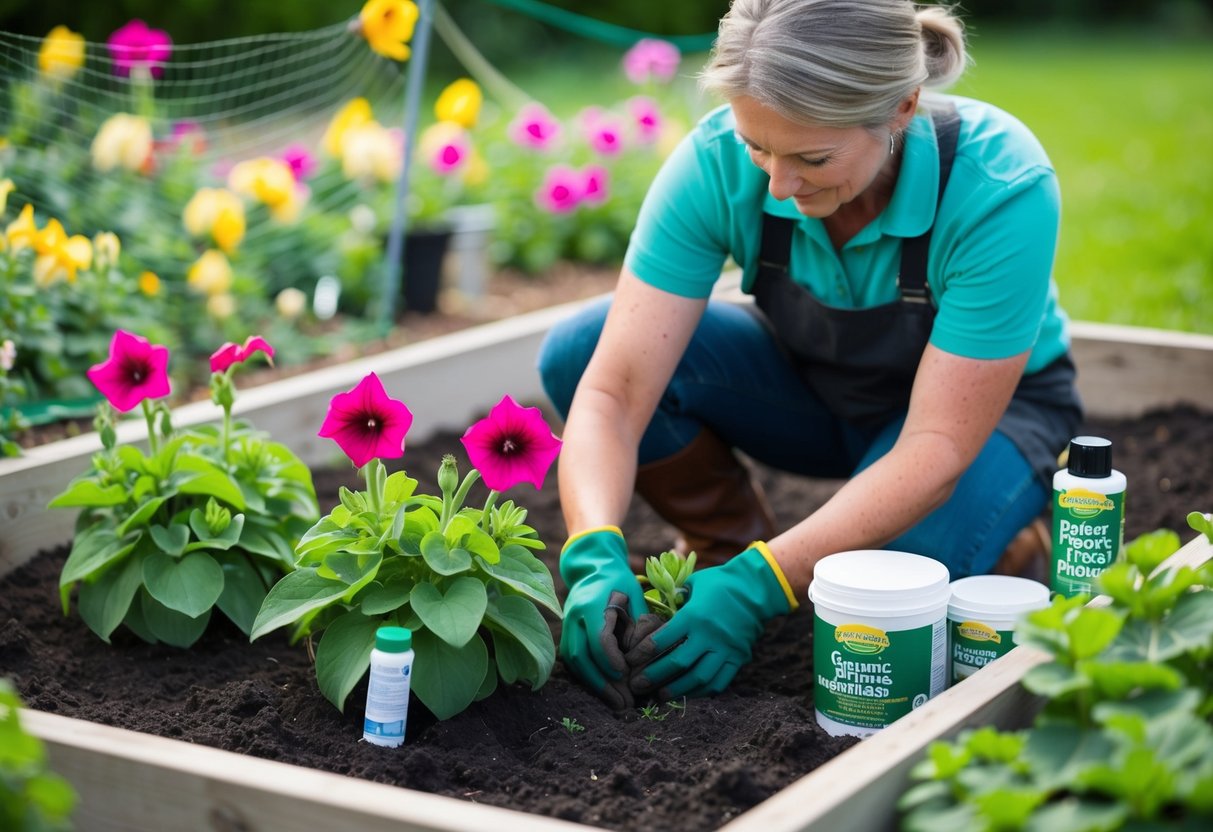
To ensure your petunias thrive, it’s important to address both pest infestations and disease threats. Managing pests like aphids and slugs is key to keeping your flowers healthy. Addressing diseases such as root rot and powdery mildew will also help maintain vibrant blooms.
Common Pests and How to Handle Them
Petunias can be affected by pests like aphids and slugs. Aphids are tiny insects that suck the sap from plants and are often found on the undersides of leaves. To get rid of them, you might use insecticidal soap or a strong spray of water to dislodge them. Slugs are more active at night and leave slime trails. You can control them using slug traps, or by hand-picking them. Budworms may also damage flower buds, so staying vigilant is key. Regularly check your plants for pests and act quickly to prevent further damage.
Disease Prevention and Management
Diseases like root rot and powdery mildew can harm your petunias. Root rot often occurs in poorly draining soil, leading to wilting.
To prevent this, ensure your soil drains well and avoid overwatering. Powdery mildew is a fungal disease that appears as white powder on leaves.
Increase air circulation around your petunias by providing enough space between plants. If you notice interveinal chlorosis, it could indicate an iron deficiency.
You can amend the soil with iron supplements to correct this. Always remove infected plants promptly to stop the spread of diseases.
Regularly monitoring your petunias helps catch any issues early, ensuring your flowers stay healthy and bloom beautifully.







